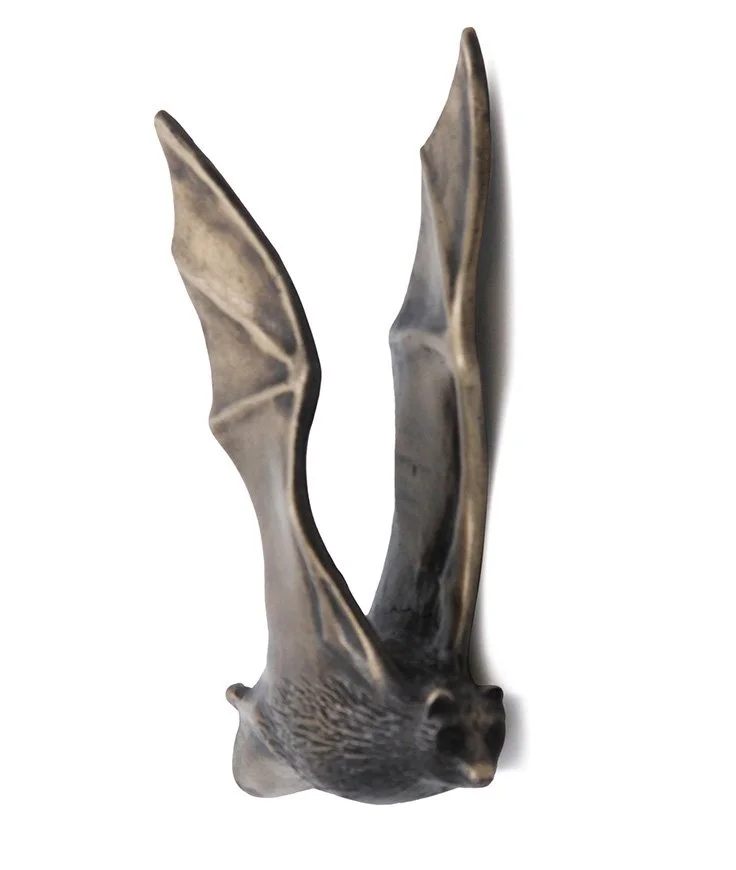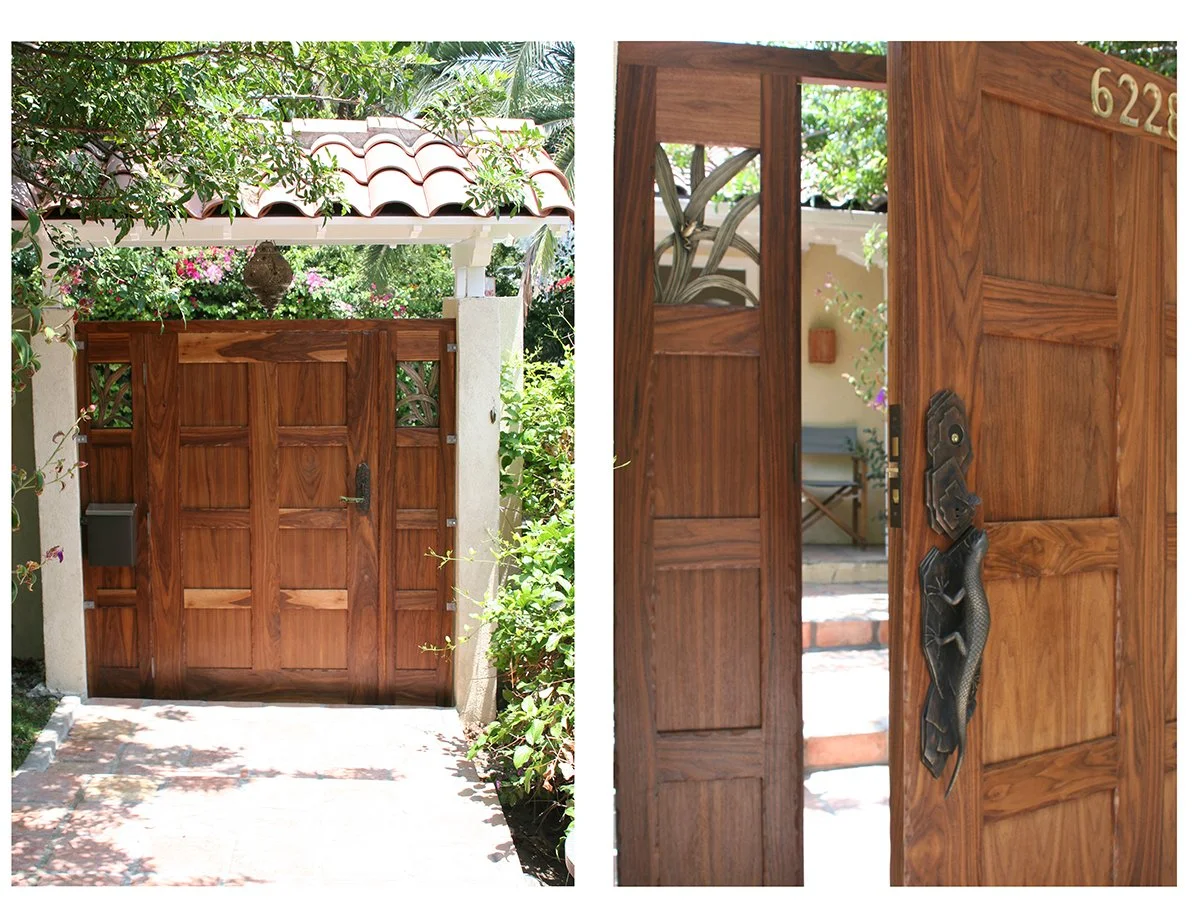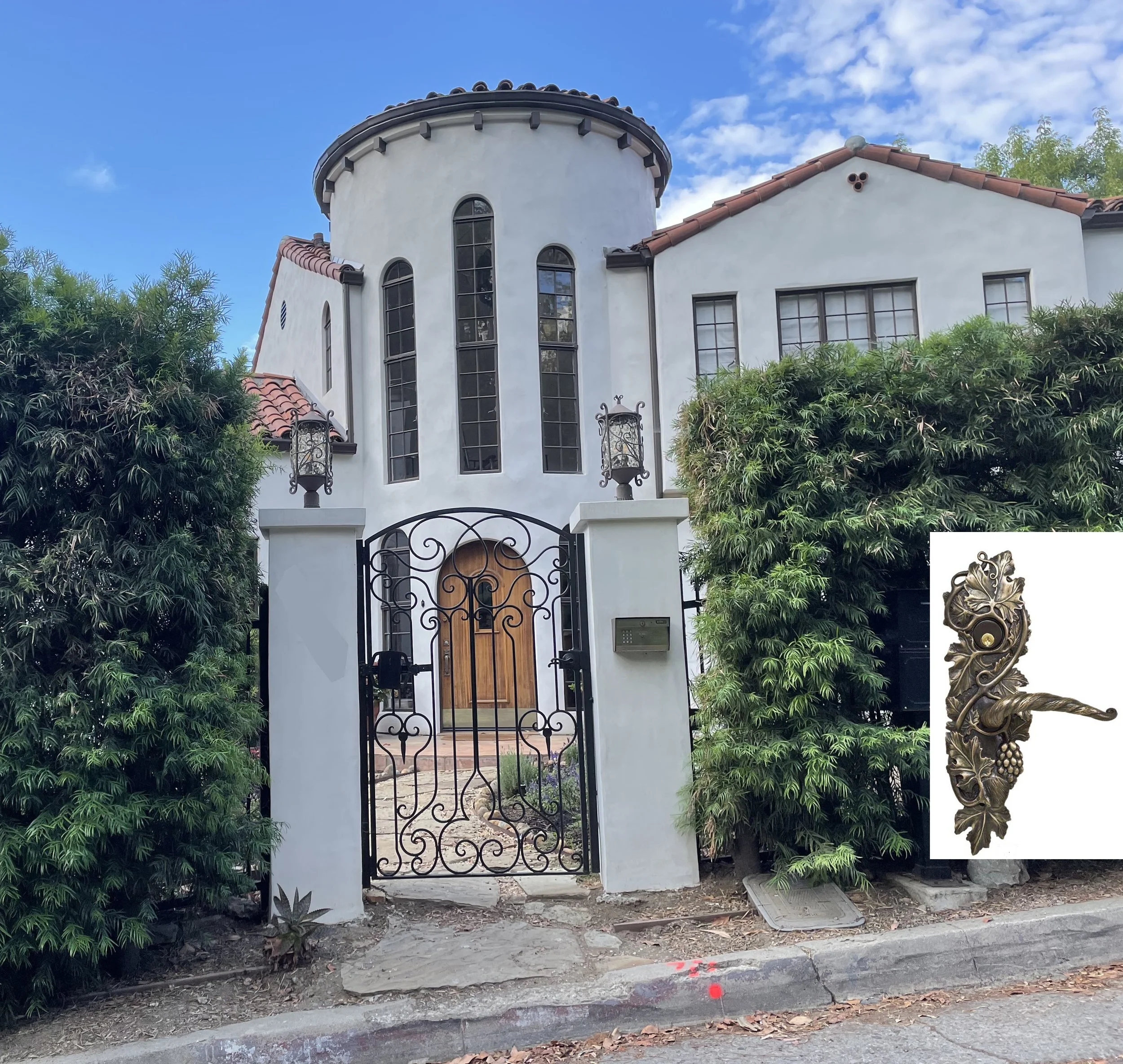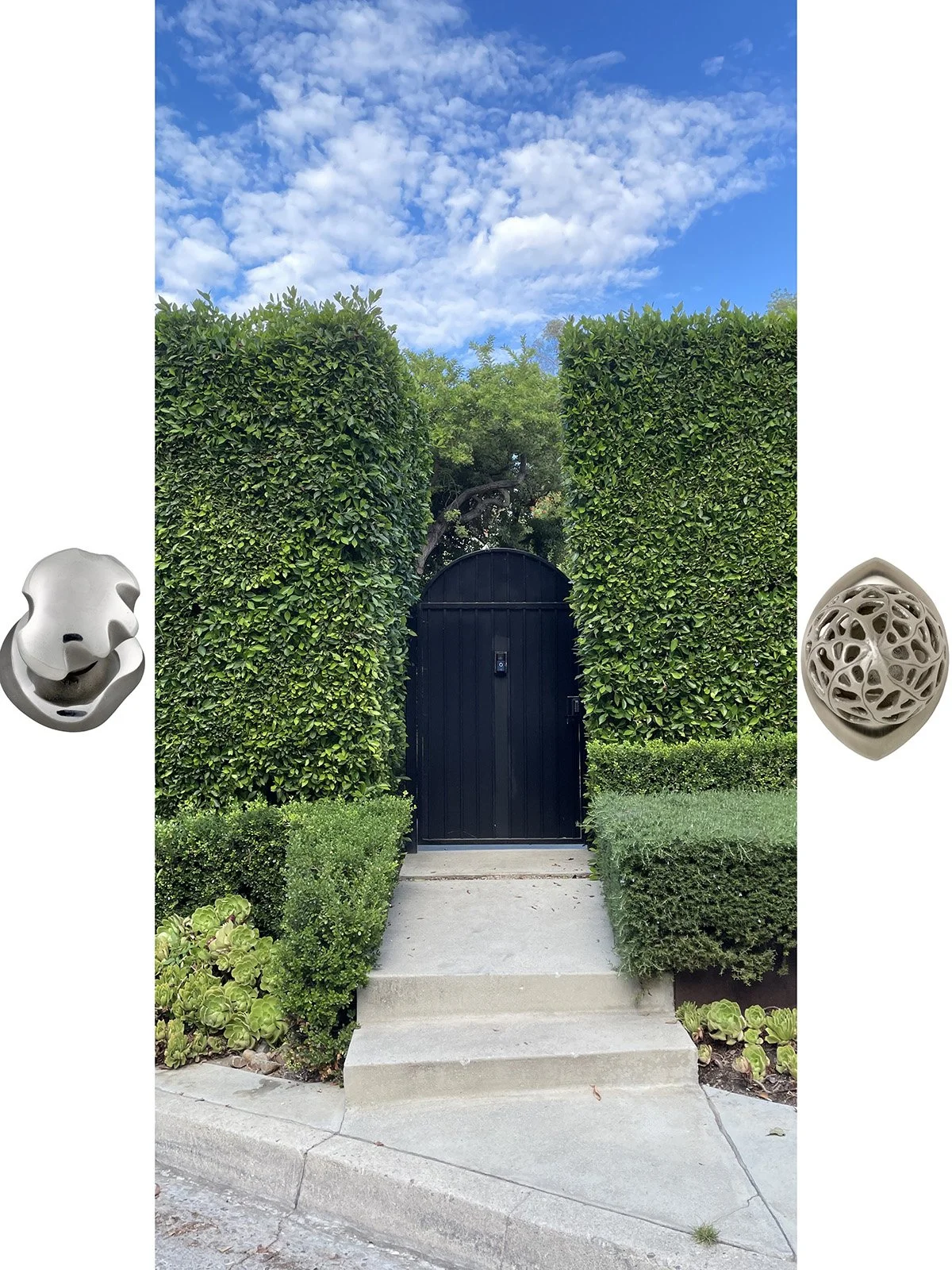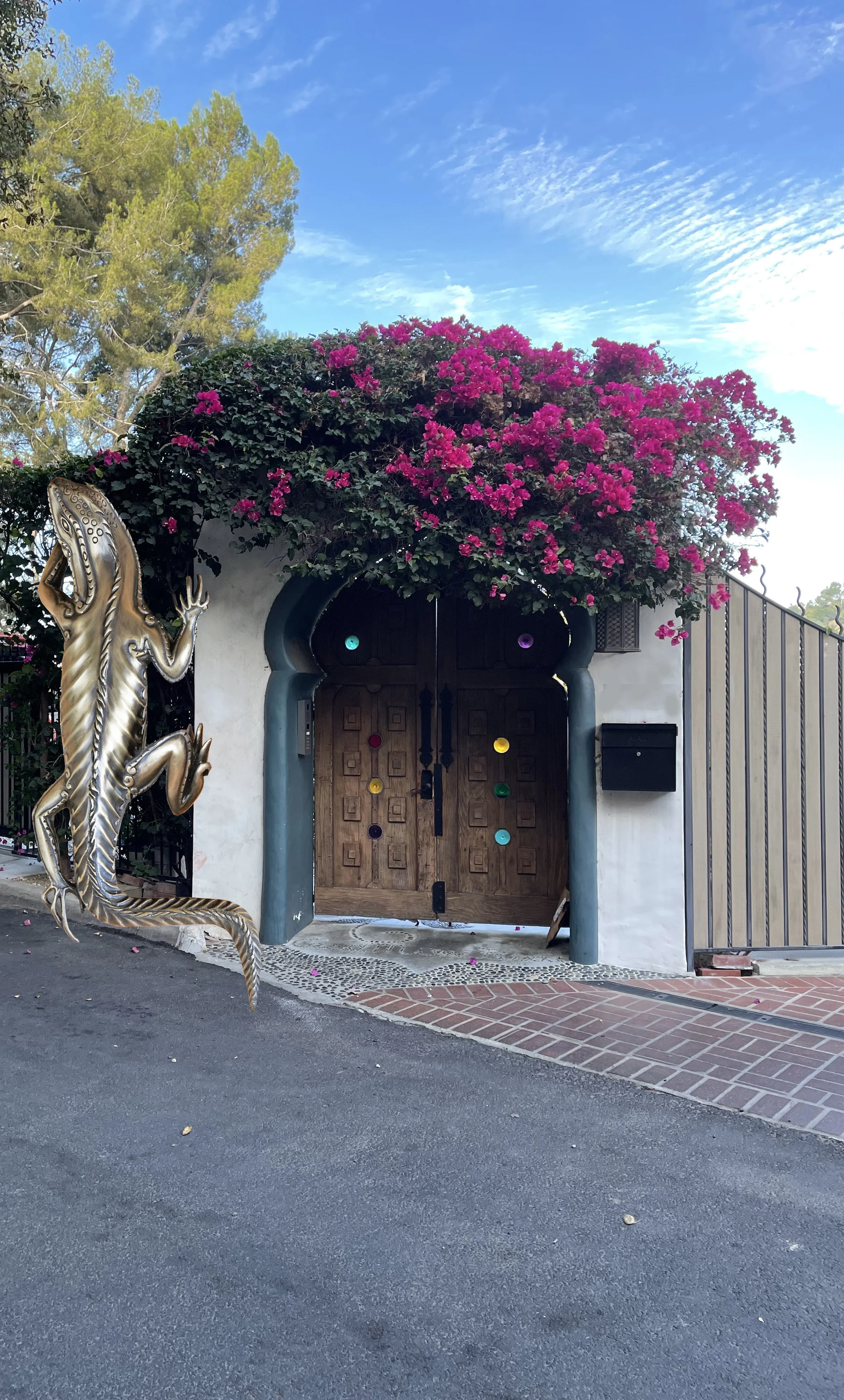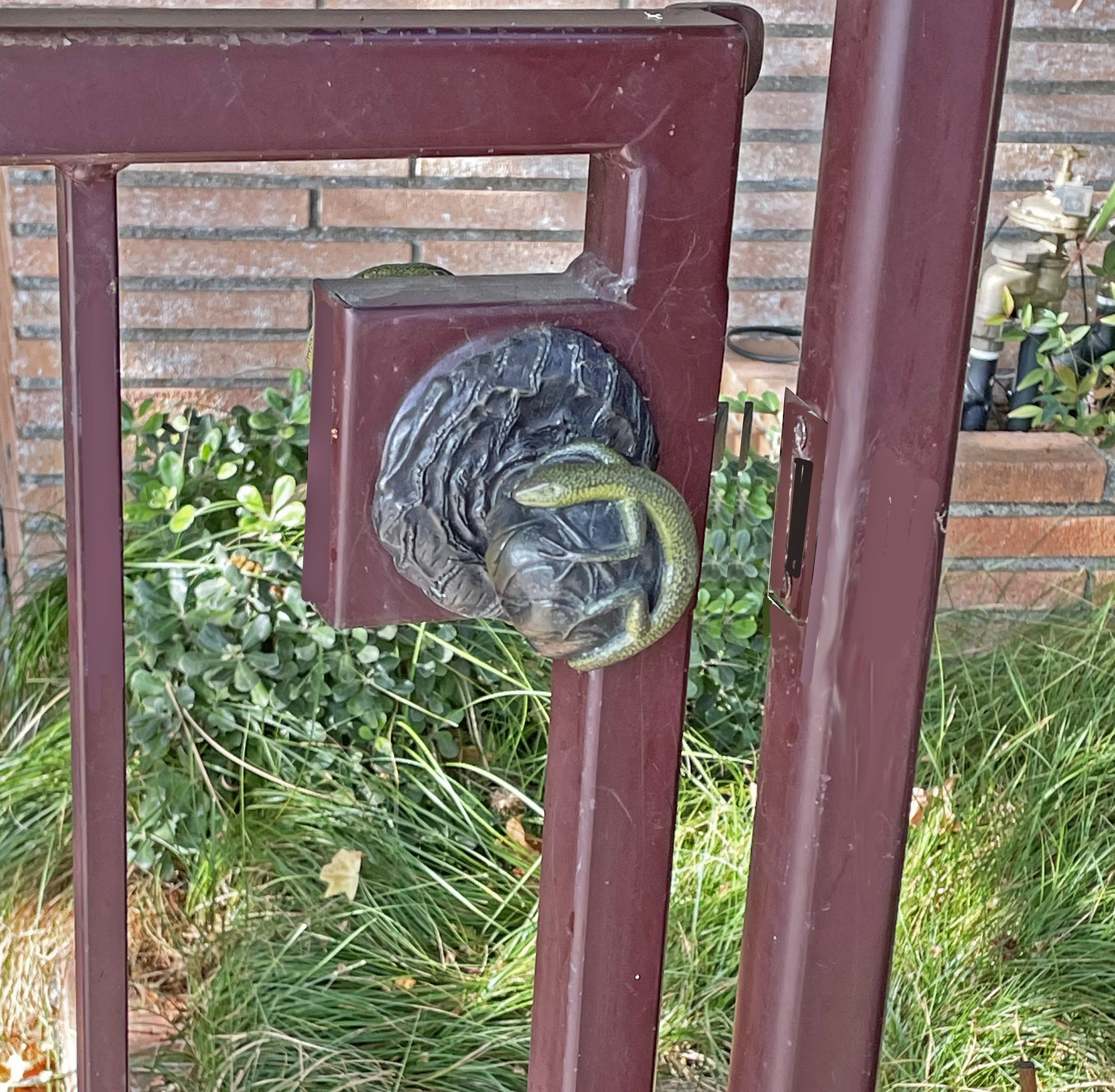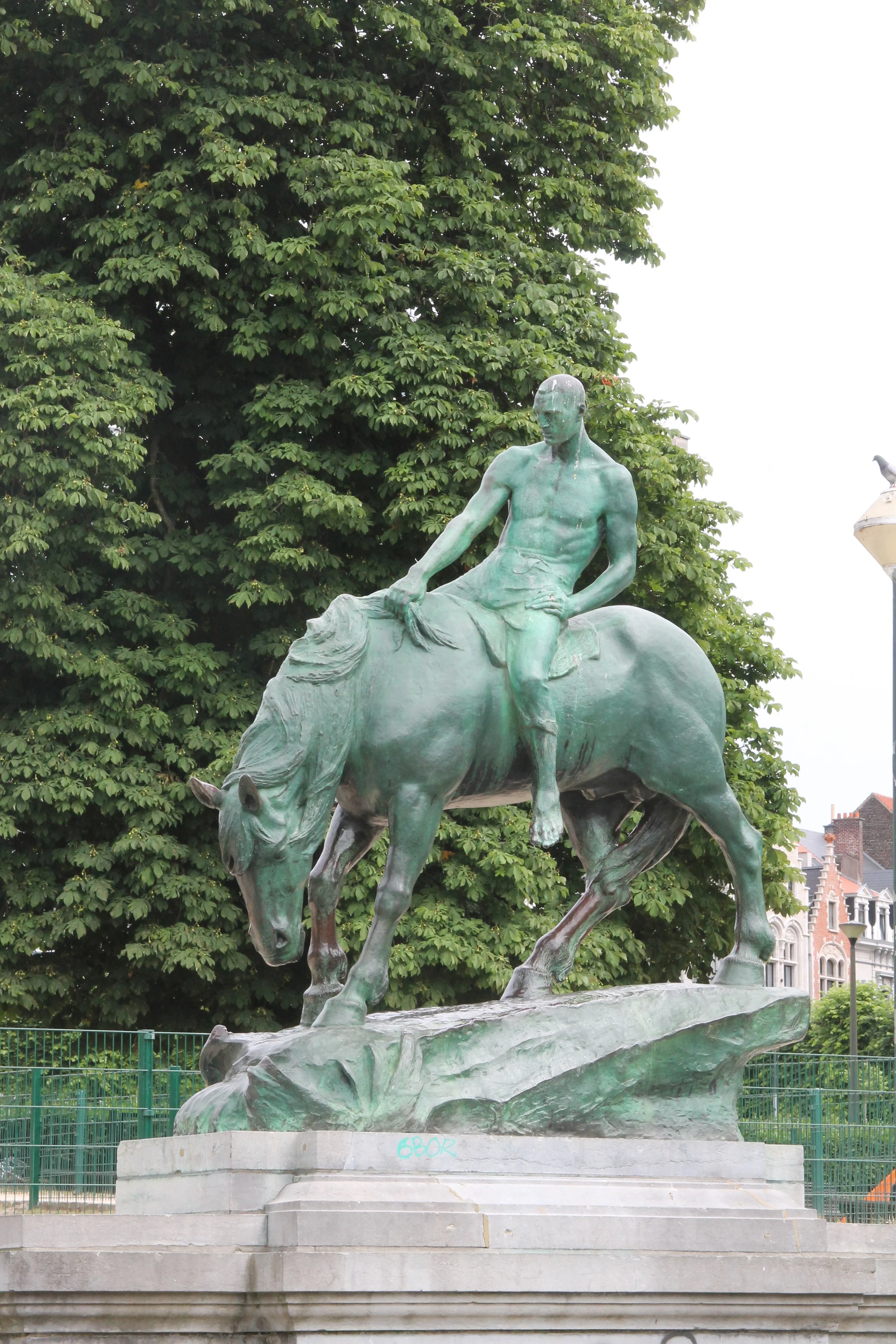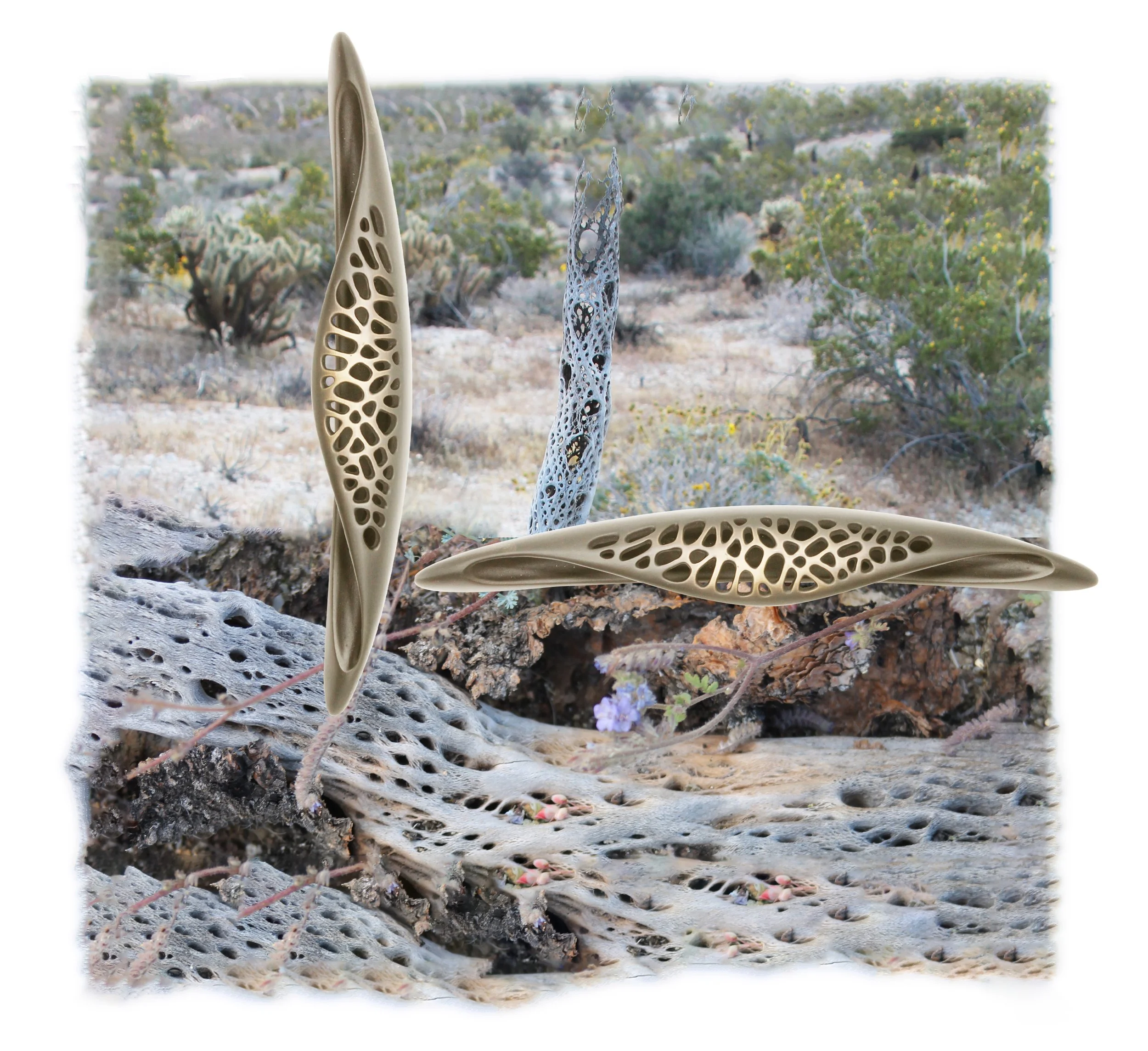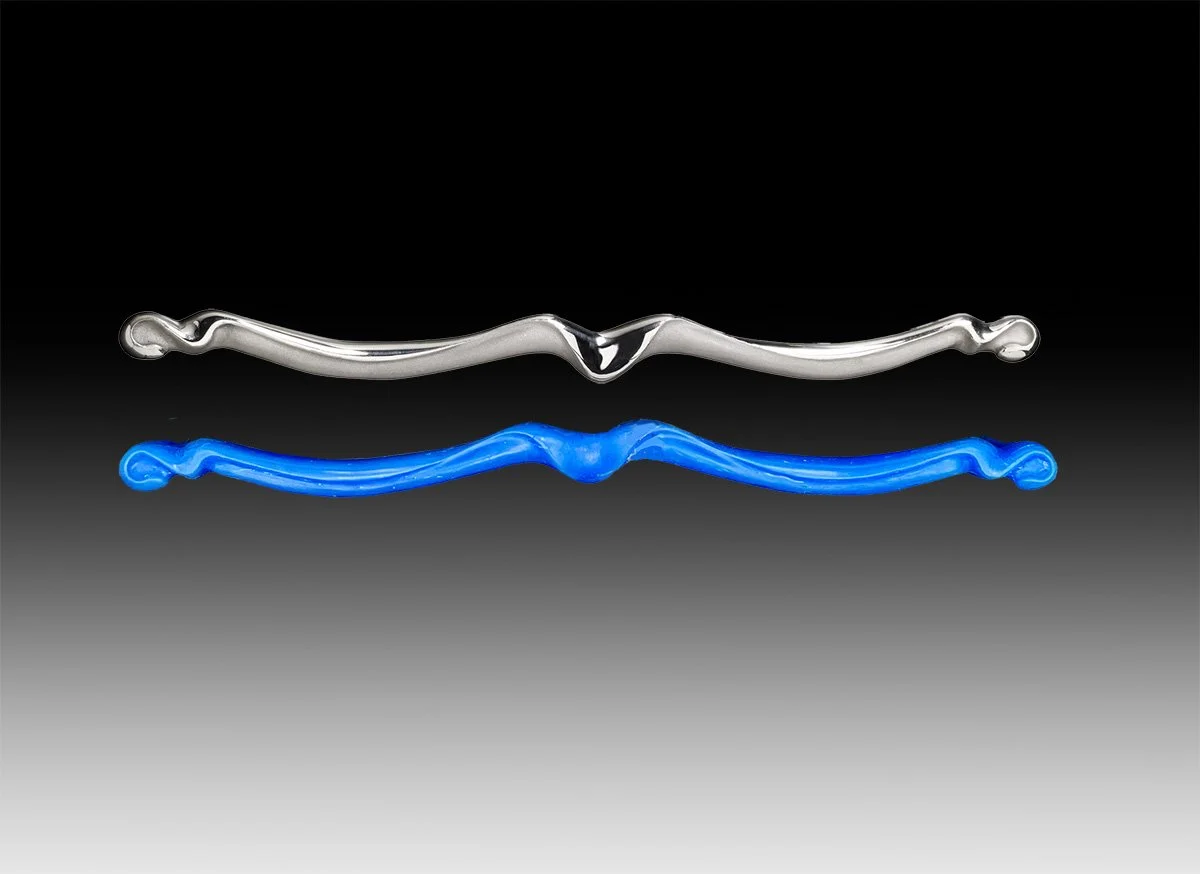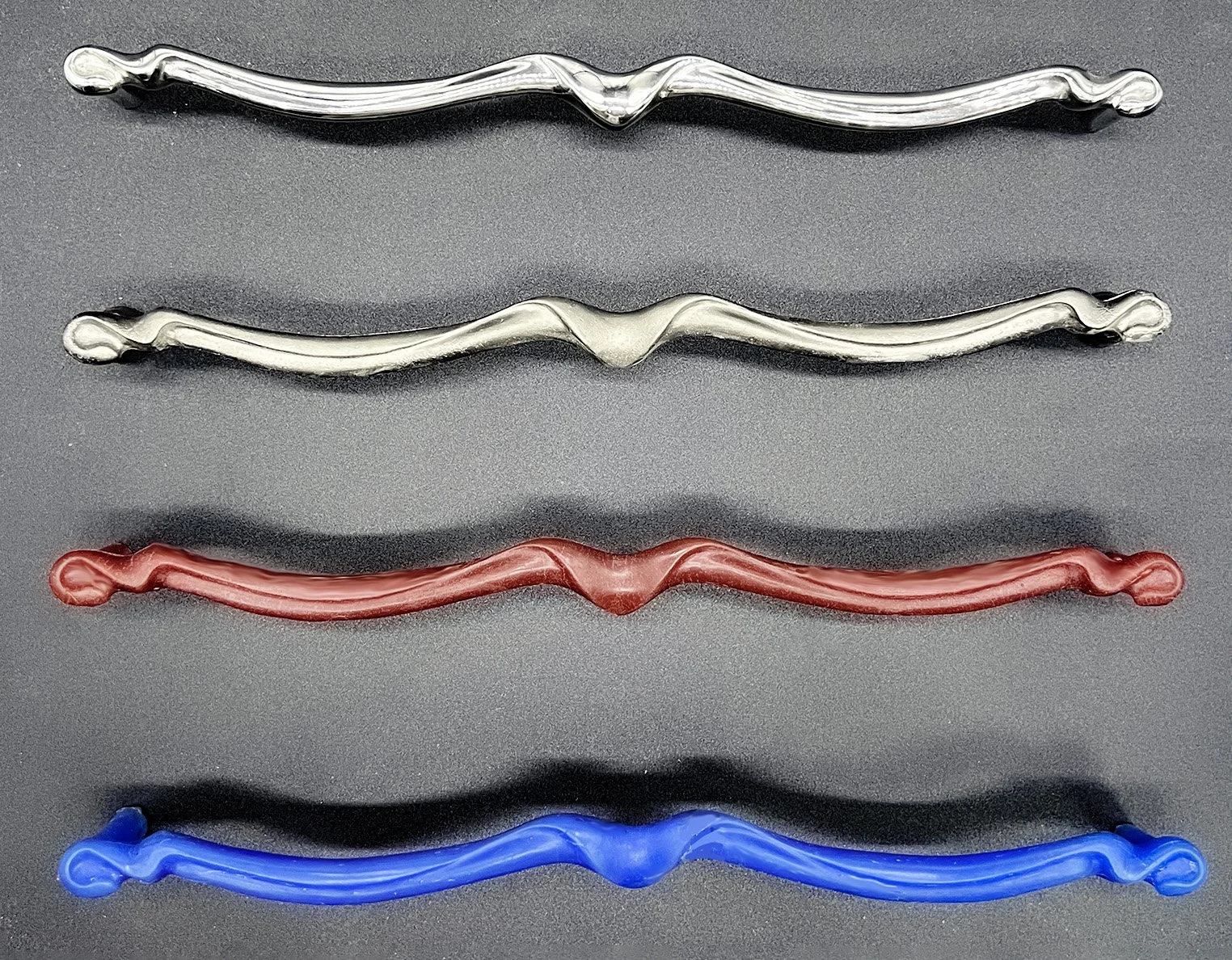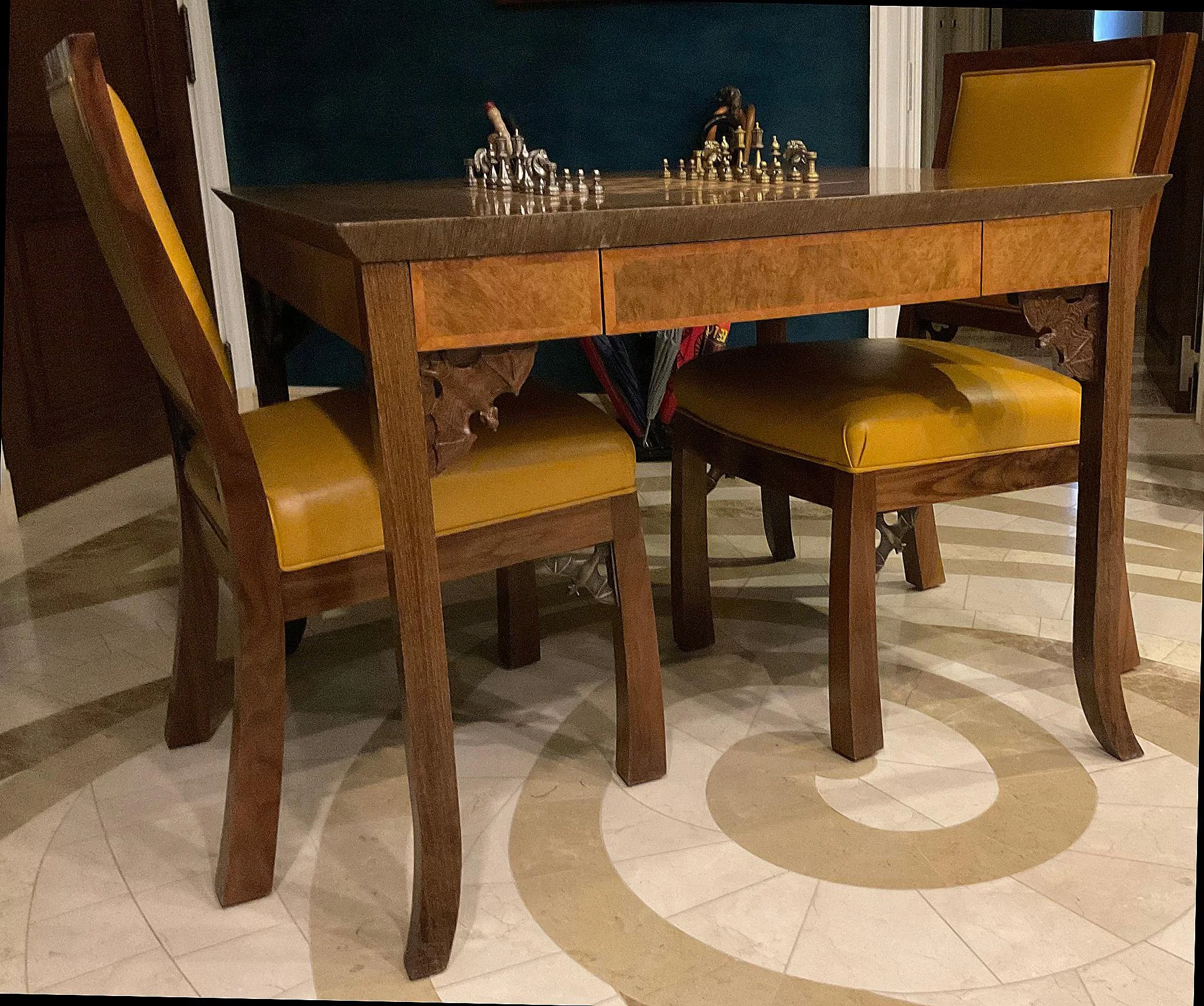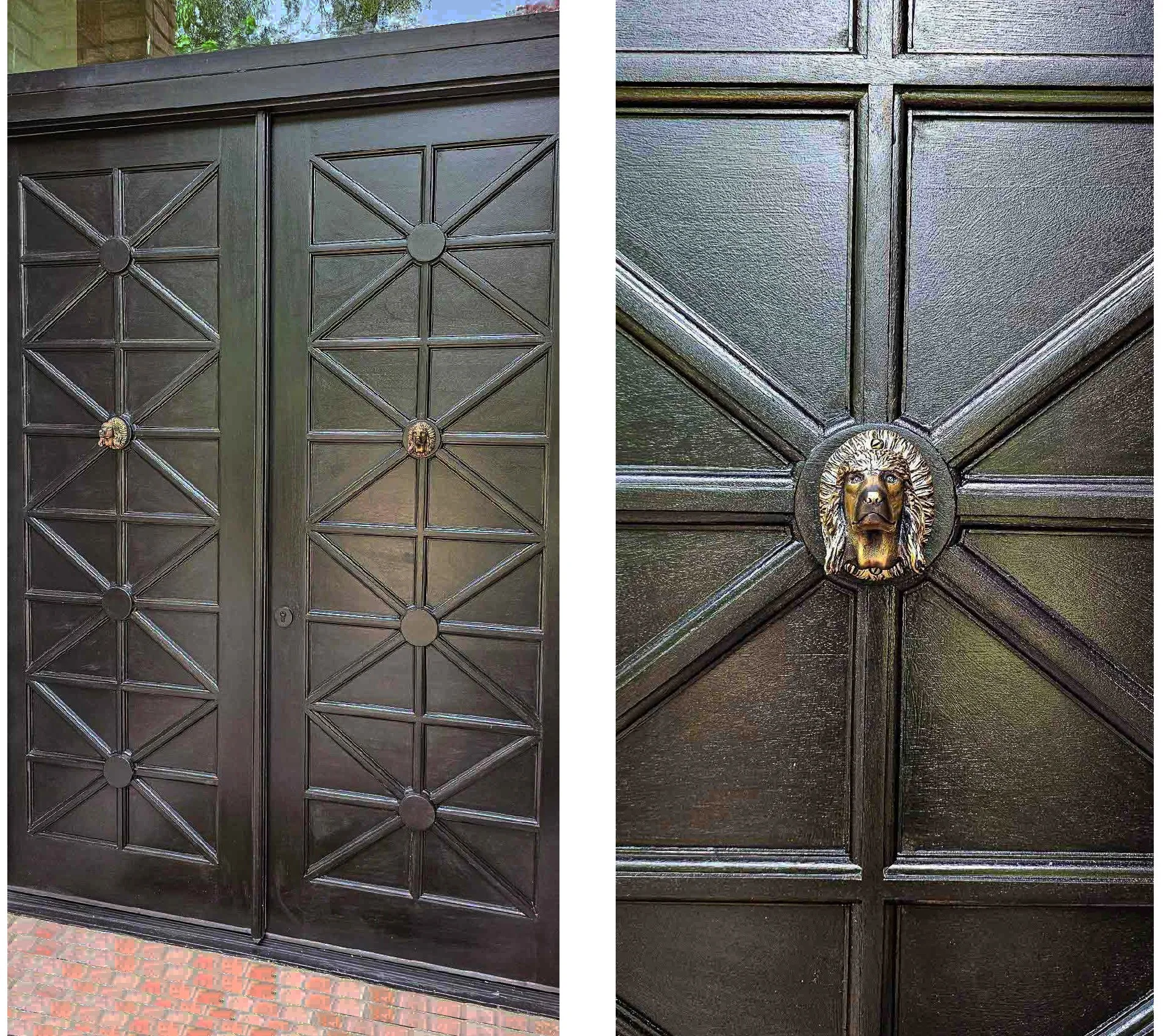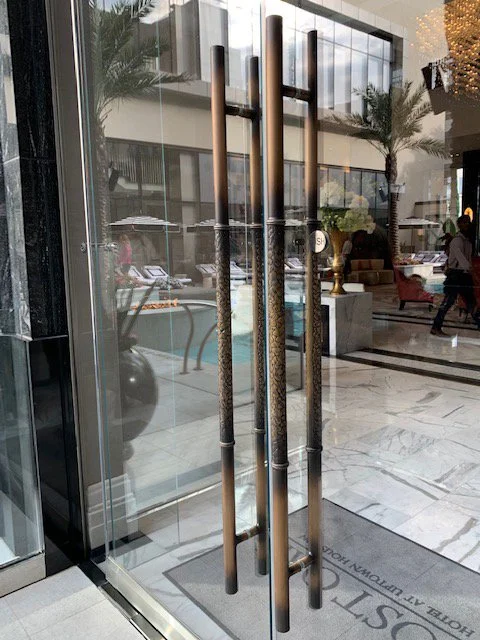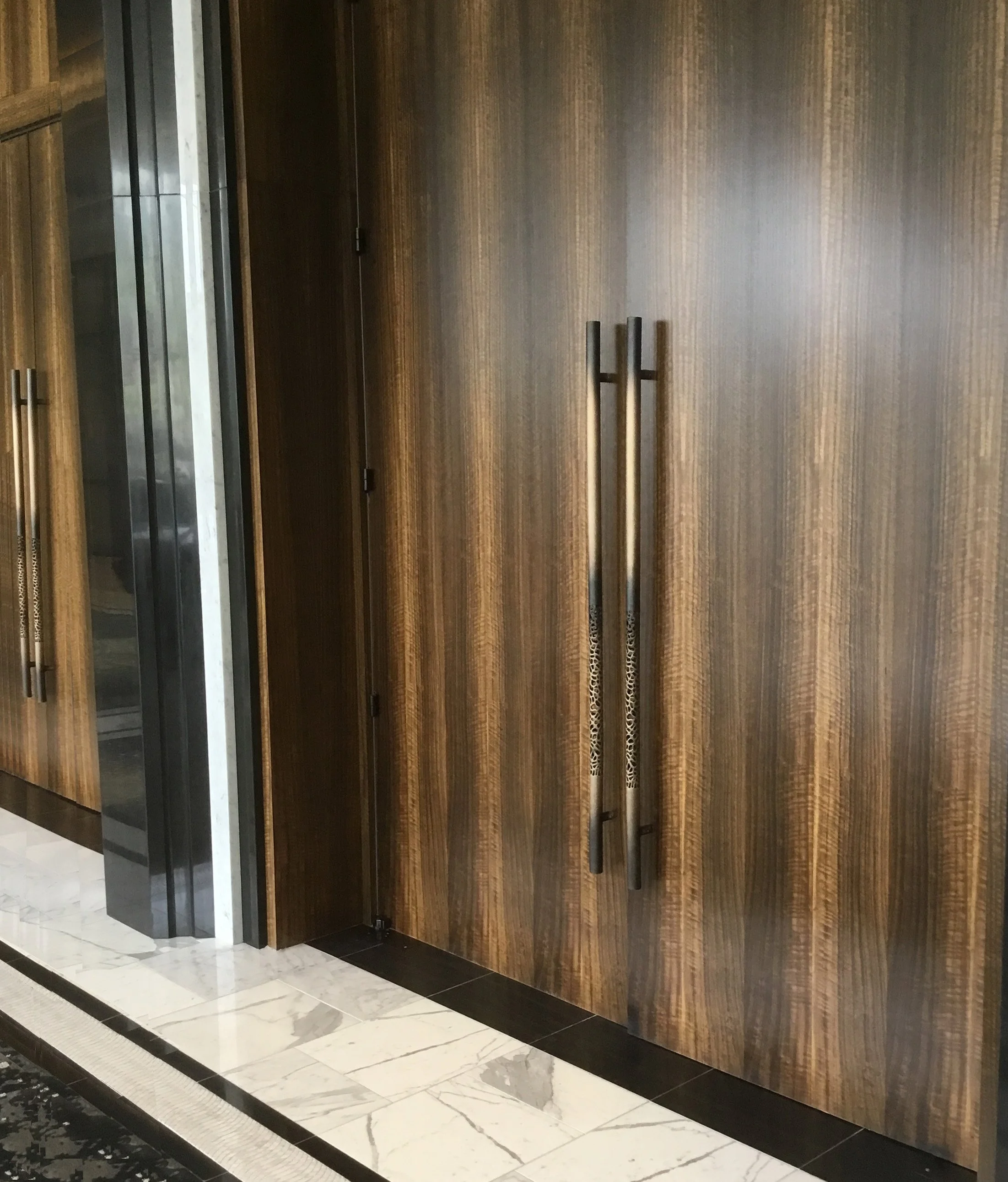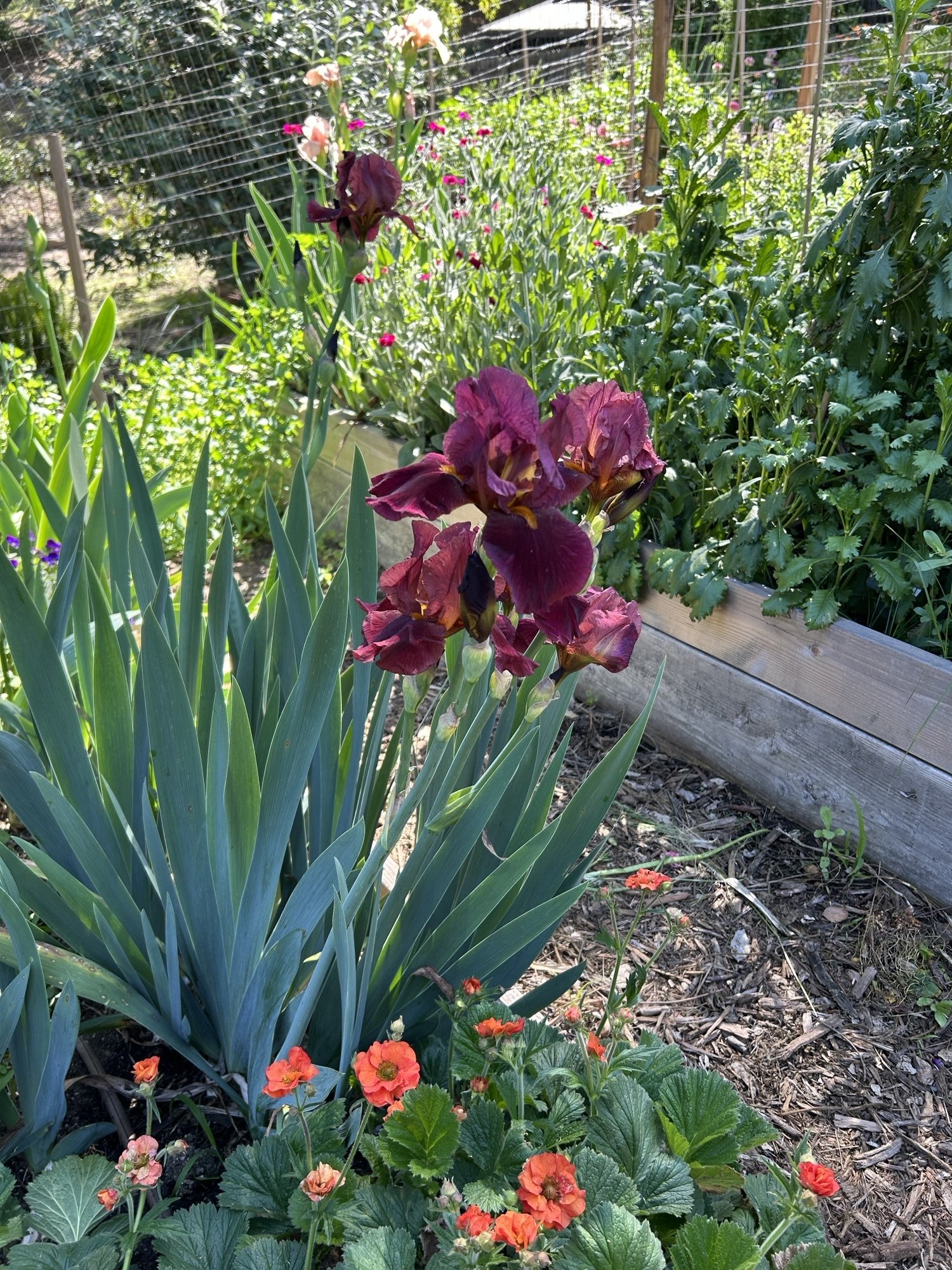Decorative Hardware for Electric Mortise Locks: Blending Technology with Handcrafted Design
When one considers electric or remote door locks, there’s a tendency to associate these high-tech methods of egress with contemporary door trim. There’s also a tendency to extend this assumption with the presumption that the trim will be made of stainless steel.
Full disclosure — this is a bias that I too harbored, until an imaginative designer re-envisioned his Willow entry door handle sets, transforming them from manually operated to electrically controlled.
Accurate Lock has been mentioned in many of our posts as a trusted maker of mortise locks. It remains the only company whose mortises we use and configure our door trim to fit. Their new electric M1934ELR mortise builds upon the same solid foundation as its manual counterpart and requires only minimal modification to function with our entry lever sets.
The M1934ELR electric mortise does, however, need to be planned for early in a project — ideally when the doors are being ordered — to ensure that a power source can be incorporated into the door itself.
Accurate also makes the SM9159E, a Wi-Fi and Bluetooth-activated mortise that operates on four AA batteries. This model offers an alternative to their fully wired version, and while battery life may be a concern, the unit includes a low-battery indicator. Most door makers are accustomed to working with mortise locks, but these particular models must be considered during door construction, as they are encased in a 6”H × 1½”W metal box that fits inside the door’s hollow section.
While the Accurate SM9159E will function without external power, it relies on Wi-Fi connectivity and allows for remote control of the locking function.
Trim Considerations
The electric mortise requires two modifications to the decorative trim and mechanism. Because the lock’s CPU controls the throwing and retracting of both latch and deadbolt, the exterior lever or knob must be fixed from the outside but remain operative from the inside.
To achieve this, the spindle passing through the door and lock must be split so that only half of it moves. The lock’s CPU also controls the deadbolt electrically, but for power outages or emergencies, the deadbolt can still be operated manually — by key from the outside or by turning the thumb piece on the inside.
As technology reshapes architectural design, we continue to collaborate with designers who seek both beauty and intelligence in their entry systems. Our Willow lever sets, when paired with Accurate’s electric mortise locks, offer a refined solution for projects where high design meets high performance.
Gate Hardware Essentials: Style Meets Function by Martin Pierce
The beauty of the Hollywood Hills, especially in the higher reaches near Mulholland and Hollyridge Drive, is a constant sensory pleasure that starts my day energized and calm. Having walked the hills for many years, I decided to mentally catalogue and digitally record some of the beautiful gateways that front these and other ridges. Whether it is a wooden gate, one of wrought iron filigree, a driveway gate, or a garden gate, all are enhanced by the foliage native to these hills.
Entry Gates
Trumpet flowers and pink bougainvillea encase the custom bronze gate handles on this walnut-paneled entry. The gate’s keyed cylinder, gate lever, and thumb latch are used to activate a secure mortise lock. The large lizard functions as the gate pull, and the butterfly, when depressed with one’s thumb, retracts the deadbolt gate latch that keeps the gate securely closed even if the gate is not key-locked.
The mortise lock, made by Accurate Lock, also has an interesting toggle on the side that, when pushed in, prevents the lock system from locking but allows the gate to remain closed. When the toggle is released, the gate will automatically lock when closed. This is a sophisticated gate system that works well and allows the homeowner maximum control over security, depending on need, from popping out to trim the hedge to fully locking when leaving for longer.
On the reverse side, the locking system is activated by a lizard lever that retracts the tubular latch and by the Beetle turn-piece that unlocks the cylinder and mortise. Since the gate is solid wood and very heavy, it required three sets of 6-inch stainless steel butt hinges. The hinges may have been overkill, as we chose 316 marine-grade stainless steel, but this alloy provides exceptional tensile strength and easily supports the weight of the wide gate.
In the entry gate shown here, the lighter weight of the open wrought iron filigree allowed for a more customized and decorative hinge, also fabricated in wrought iron. It is difficult for this writer not to imagine Martin Pierce’s hardware as an alternative lever option, and the Grapevine lever seemed like a good candidate that I would have considered as a complementary style choice.
The garden entry gate below is gracefully framed by a mature Ficus, or Indian Laurel Fig, softened by a manicured Boxwood hedge. Though the gate itself seems almost secondary to the lush foliage, an entry knob from the Morphic or Ergo collections could serve as a jeweled accent, much like a pendant that completes a black dress.
Framed by cascading bougainvillea and set within a deep, keyhole arch, this garden gate reflects the Moorish and Spanish Colonial revival styles that found their way into the Hollywood Hills in the early 1900s, influenced by the nearby Theosophical Society’s Krotona colony. The carved wooden doors, inset with jewel-like circles of colored glass, suggest a mystical quality that distinguished hillside architecture of the time. For this post, I have superimposed one of our sculptural iguana pulls, a piece whose scale and detail echo the whimsical ornament favored in that era, inviting the viewer to imagine how hardware can transform a gate into art.
Not all gates need to be large or custom-made to make a statement. A neighbor of mine chose a simple iron gate, but with the addition of a friendly bronze lizard it was transformed into something both striking and refined. When the gate was first installed, the mailman, who was not fond of reptiles and was momentarily fooled by the realism of this Anole lizard, suffered a moment of panic before realizing the creature was cast in metal.
Sherlock Holmes – the Case of the Mystery Cleaner
One of the challenges of bronze is explaining how its long-term, ever-changing beauty is due to patination—a process that naturally turns the surface varying shades of blue, green, and dark brown over time. It is this very process that draws tourists to the beautiful roofs of Europe’s cathedrals and other landmark buildings and sculptures. Over time the elements interact with the copper component to produce red‑brown cuprous oxide, dark brown‑black copper sulphide, or blue‑green copper carbonate. The patinas that occur during this oxidation process are on the surface of the bronze and they seal and protect the piece, adding to its structural durability by creating a living, changing patina.
The purpose of this post is to balance the pros and cons of how best to keep the bronze in its natural golden state and how different sealants protect bronze hardware.
Emile Meunier’s Cheval
Sealant Options for Natural Brushed Bronze
A sealant is a coating that helps prevent oxygen and moisture from reacting with copper and other alloys present in bronze. They range from simple waxes to clear powder coating, to baked enamel and acrylic and polyurethane lacquers. They vary in how they are applied, how hard they are, how easy they are to clean, and how difficult they are to repair if the surface coating is damaged. As a generalization, harder sealants like powder coating deliver a tougher coating that requires little maintenance, but if damaged cannot be repaired easily on site.
Powder Coating Clear
When we powder‑coat bronze our door handles and cabinet pulls, we use a UV‑stable polyester powder which is sprayed onto the bronze. The spray gun has an electrode that gives the powder a positive electrostatic charge and as the bronze is grounded through a copper conductive cable, the charged powder clings to the bronze. Once heated, the powder becomes chemically cross‑linked to create a uniform, very tough layer that bonds to the bronze surface.
Powder coating is an excellent finish choice for luxury exterior hardware particularly where salt air is present. It offers a good level of resistance to many chemicals and the effects of UV. It also does not require frequent maintenance and dirt and grease are easily removed with a soft cloth and pH‑neutral soapy water. The main drawback is the thickness of the coating, which tends to soften edges and, in the case of our luxury bronze door handles, can detract from the hardware’s design appeal. It also gives the piece a more plastic appearance and one that feels less tactile than simpler waxed finishes.
Clear Lacquer Sealants
These come in three forms—polyurethane, polyester, and acrylic—and are applied by spraying the bronze and then allowing the surface to cure either by evaporation or by baking.
They differ in their curing methods, toughness, and ability to resist degradation through exposure to sea salt and chemicals. Of the three, a 2K polyurethane spray offers the toughest finish and, like powder coating, it chemically cross‑links with itself to form a tough coat. Acrylic lacquers offer a reasonable option for outdoor applications and, like 2K polyurethane finishes, have the advantage that they can be refinished on site. Baked liquid polyester offers a tougher surface than acrylic lacquers but, as it is a baked‑on finish, cannot be refinished on site and must be returned to the supplier for re‑coating.
Mother Nature and the Old‑School Oil Rubbed Finish
We offer oil‑rubbed light and dark finishes for most of hand-crafted hardware by immersing the piece in an acidic solution followed by immersion into a neutralizing solution. The bronze will still continue to oxidize, so to slow the process down we apply a coat of microcrystalline wax made from very fine, tightly packed, pliable, high‑oil wax derived from refined petrochemicals or plant‑based carnauba wax. Regular maintenance will preserve the finish and dirt can be removed simply with a soft cloth and, if needed, pH‑neutral soapy water always applied with a soft non‑abrasive cloth. The wax can be reapplied as needed and should be included in the maintenance protocol.
Keyed adhesion
In all methods when the finish is liquid it will adhere and penetrate the surface where there are any pin holes and cling to slightly roughened areas, this is not a chemical cross linking but rather describes another way the finish adheres to the surface.
The Cleaner
The mystery began when our Ergo Wave custom bronze cabinet pulls developed unexpected red-brown stains several months after completion.
These luxury bronze hardware pieces were left in a brushed natural bronze and sealed with an acrylic lacquer finish—a coating that, once cured, is hard and moisture-resistant but never completely solvent-proof.
Photographs taken by the designer documented the hardware in pristine condition at pickup, delivery, and installation.
Yet weeks after the homeowner moved in, stains appeared on nearly every pull—and always in the same location.
Our best theory is that the housekeeper’s regular cleaning routine introduced the culprit.
A household cleaner with either an acidic or alkaline formula may have been sprayed directly on the pulls.
Even though the lacquer had fully cured, repeated contact with a cleaner such as vinegar, lemon-based sprays, or ammonia solutions (like typical glass cleaners) can micro-pit or etch the acrylic film.
We suspect that after spraying, the pulls were not thoroughly dried, allowing cleaner to pool along the back top edge where the pull meets the drawer front.
This residue gradually breached the lacquer, exposing the bronze beneath.
Once exposed, the copper content in bronze reacted with ambient moisture and oxygen, forming a cuprous oxide layer that appeared as a powdery red-brown stain.
The pulls have since been carefully re-buffed to remove the oxide and will be re-finished with a UV-resistant polyester powder coat for greater chemical durability.
Advice for Owners & Designers
Even the best protective finishes are not indestructible.
Whether it’s acrylic lacquer, clear powder coat, or baked enamel, any surface seal can fail if scratched, chipped, or repeatedly exposed to harsh cleaners.
Once the barrier is compromised, moisture, oxygen, and cleaning agents accelerate oxidation and the discoloration will spread.
Recommended bronze cabinet pull care:
Use a soft microfiber cloth for routine cleaning of luxury bronze hardware.
If needed, wipe with pH-neutral, lightly soapy water only. Do not spray.
Rinse and dry thoroughly—do not allow moisture or cleaner to pool.
Inspect hardware periodically and touch up or re-coat at the first sign of wear.
Following these steps will protect both the acrylic lacquer finish and the natural bronze beneath, ensuring your custom bronze cabinet pulls retain their beauty and warm patina for years to come.
Test post for our Facebook Connection
Oh the joys of contemporary life! As our connection to Facebook readers seems to have come adrift we are re-connecting, hence the test post. Thank you.
Silicon Bronze vs Brass: Antimicrobial Door Handle Performance
I have always assumed that the primary reason for choosing brass over bronze door handles was aesthetic, since brass has warmer, golden-red tones, while silicon bronze leans more toward a champagne hue. The second assumption is that brass is somehow the superior alloy. But if measured by durability, strength, and corrosion resistance, the clear winner is bronze, not brass.
This week I uncovered a third misconception — that brass has superior antimicrobial properties compared to silicon bronze. That discovery led me into a deep dive into how each alloy is able to kill microbes, and into what microbes actually are and I thank Kylie Kerber at Borachitecture for her questions that prompted this search.
Copper is the key element in this story. It has the ability to kill microbes, and silicon bronze is especially rich in copper, containing between 92% and 96%. Brass, by comparison, has less — typically about 60% to 70%.
Outdoor Use
This is where the science gets really interesting, and where the added durability of bronze gives it a further edge over brass. Central to both alloys is their ability to release copper ions. At the surface, copper atoms oxidize, lose electrons, and become positively charged ions. These ions are naturally attracted to the negatively charged surfaces of microbes, where they bind, disrupt cell membranes, and ultimately destroy the organism.
When a natural patina develops, it does not form as a perfectly uniform layer. Instead, it covers the handle unevenly, leaving areas where copper ions can still migrate to the surface. As a result, both brass and bronze continue to kill microbes even when patinated, though the process slows compared to a freshly polished surface. Bronze, with its higher copper content and greater resistance to corrosion, tends to maintain this antimicrobial effect more effectively outdoors than brass. Furthermore, because brass is a softer alloy containing zinc, it is prone to corrosion and pitting in outdoor environments. As the zinc oxidizes and degrades, the surface becomes porous, accelerating the handle’s overall deterioration.
Indoor Use and Polished vs. Brushed Finishes
Copper content still gives silicon bronze the edge indoors, but the luster or finish of a door handle also plays a role. The word polished is almost synonymous with brass — hardly surprising, since brass positively gleams when polished. However, polished surfaces are effectively flatter, while brushed surfaces at a microscopic level have peaks and troughs. Consequently, a brushed finish has a greater surface area, meaning more copper atoms are exposed at the surface to release ions and kill microbes. To keep this antimicrobial property and regardless of alloy the door handle will need frequent cleaning with a soft cloth to remove surface contaminants.
Speed of Action
Copper ions attack microbes on multiple fronts — from breaking down their outer cell walls to binding with DNA and RNA. These actions both hasten cell death and prevent microbes from replicating. Scientific studies on bronze door handles show bacteria kill times of 60 to 200 minutes versus 60 to 270 minutes when they landed on brass and the speed would be greater if the surface was brushed.
While far from being a microbe, the perforated forms of the Morphic design trace back to my early fascination with foraminifera — tiny ocean organisms whose lace-like shells left a lasting impression. Their natural geometry continues to inspire my sculptural hardware, reinforced by repeated encounters with desert landscapes and the skeletal lattices of cholla cactus. In both cases, the Morphic Collection of door handles can be seen as a translation of nature’s skeletal geometry — an echo of open frameworks transformed into functional art
This post is based on trusted sources, including the EPA, CDC, and peer-reviewed studies on copper alloys. Please see the links below to explore further studies on this subject.
References
U.S. Environmental Protection Agency (EPA). EPA registers copper-containing alloy products. Available at: https://www.epa.gov/newsreleases/epa-registers-copper-surfaces-residual-use-against-coronavirus — This EPA release notes that antimicrobial copper alloys are approved for products like doorknobs and handrails.
Copper Development Association. Laboratory testing shows antimicrobial copper surfaces kill greater than 99.9% of MRSA, VRE, Staph aureus, Enterobacter aerogenes, Pseudomonas aeruginosa, and E. coli O157:H7 within 2 hours of exposure.
Wikipedia contributors. Antimicrobial properties of copper. Wikipedia. Available at: https://en.wikipedia.org/wiki/Antimicrobial_properties_of_copper — Includes data on kill times for influenza A, E. coli O157:H7, MRSA, and more.
Wikipedia contributors. Antimicrobial copper‑alloy touch surfaces. Wikipedia. Available at: https://en.wikipedia.org/wiki/Antimicrobial_copper-alloy_touch_surfaces — Details EPA registrations of antimicrobial copper alloys and the bacterial species tested.
AntimicrobialCopper.org. FAQ: Laboratory testing has shown copper alloys are effective against norovirus, rotavirus, and adenovirus; based on CDC recommendations and similar genetic structures, they may also inactivate Ebola and potentially Zika.
AntimicrobialCopper.org. Results from clinical trials show that microbial contamination is significantly reduced—by 83–100%—on copper surfaces; ICU trials showed a 58% reduction in healthcare-associated infections (HCAIs) when copper alloy surfaces are used.
Lost Wax Casting – When to Make a New Mold
Creating wax replicas of an original pattern is central to the lost wax casting process, a method often used in handcrafted stainless-steel hardware, artistic cabinet hardware, and custom hardware designs. In this post, I am showcasing the 12-inch Ergo stainless-steel cabinet pull, a sculptural piece from our Ergo Collection, to illustrate the steps from wax to finished product.
- The process begins with the original pattern, carved in hard, dense blue jeweler’s wax. This step requires precision, as it sets the standard for the final piece. The handcrafted, modern sculptural cabinet pulls in both our Ergo and Morphic collections begin here.
- Next, we create a wax replica by using a silicone mold taken from the original wax pattern. This allows us to produce multiple replicas while preserving the fine details.
- The initial casting in stainless steel reveals the form but not the finish as surface imperfections in the hardware need to be corrected.
- Final piece finely sanded, spot welded if needed, sandblasted, sanded again, masked, and finished to two lusters—one satin, one highly polished.
Many hands-on artists like us use a two-part silicone rubber to create the mold. A rigid box holds the pattern in place, and then the pattern is covered in liquid silicone and left to cure. To prevent air voids that can occur inside the silicone when it is being poured, we place the mold inside a vacuum pot. The vacuum then pulls air out and draws any pockets of air caught in the rubber to the surface, thereby eliminating voids.
Silicone molds made from superior rubber, when stored properly at moderate temperatures with no ultraviolet exposure, can last decades. So, why make another mold?
- Scale of order. We are a small, limited-production company with a wide array of custom door handles and sculptural cabinet pulls and with over 300 molds ranging in size from 2” to 35”. Each mold typically yields one wax, and given the constraints of space, we only make a second mold when the size of the order or the popularity of the piece makes it worthwhile. Depending on the size of the piece, the wax can take from 45 minutes to two hours to become firm enough to be carefully removed from the mold. If production warrants, we will make a second or even third mold of the pattern to increase the speed of production.
- Customization. As artisans, we are often able to accommodate requests to shorten and sometimes lengthen a piece, provided it works within the aesthetic of the design. If the order is for one or a few pieces, then we pour each wax and modify each one by hand. If the number of pieces is significant, it makes sense to produce a second mold so we can speed up production.
- High-value item or budget. If a client’s budget permits, then for large door handles we will make a new mold to create a customized piece. This is especially the case when the piece is being slimmed down where its depth projects too far. If this were for one unit, we could make the adjustment by hand to the wax, but if four or six pieces are needed—especially when some are used as back-to-back pairs—it is important that all the pieces are exactly the same. That goal is very difficult to attain if the pieces are modified individually in wax; hence, a new mold.
We will be documenting the latter two cases in the weeks to come as we start work on a large, very custom order.
Katydom: Martin Pierce’s Surreal Bronze Insect Realm Comes to Life
Watch, and enter the realm of Katydom—where bronze insects rule”
Welcome to Katydom, a short documentary by Maria Ramirez‑Adams that transports you into Martin Pierce’s fantastical universe of oversized bronze insects and tiny humanoids. Watch as Pierce meticulously sculpts, TIG‑welds, and applies hot patinas—bringing to life a world where elevated scale and storytelling converge in bronze artistry
The short documentary uncovers the myth of Katydom, a realm born from Katydid elders, where the “Insect Race” animates the sculptures once every year.
The short film delves into the art of making sculptures in bronze from the initial design to creating a sculpture in wood to the lost wax process where the wood sculpture becomes the pattern for the mold from which a wax replica is created, shelled and reborn as a bronze casting. The skills of TIG welding and patination are also uncovered with Martin buffing and finessing a katydid sculpture.
Festival Recognition
Katydom premiered at the 2024 Culver City Film Festival and also screened at the Fine Arts Film Festival in Venice, CA—a testament to its cinematic and artistic resonance.
This film is not just a visual journey—it's an intimate window into Martin Pierce’s imaginative creative process. Whether you're a sculptor, fantasy lover, or just curious, Katydom invites you to explore the intersection of art and narrative in bronze.
Whimsical Accents - Then and Now
A recent trip—first to the Midlands in England and then to New York—became an unexpected case study in whimsical carvings and hardware, each piece telling a story through design and symbolism.
Feathers’ Hotel Ludlow, Shropshire, England photo by Martin Pierce
It began in the town of Ludlow, Shropshire, at the Feathers Hotel, built in 1619 and a stunning example of the town’s Jacobean timber-framed architecture. A closer look revealed a particularly odd carving of a man’s head that appeared to be either scowling or crying (possibly both). Delving into the symbolism of the period, I learned that such carvings are known as “grotesque” or “morality” figures—often caricatures of people embodying anger, gluttony, envy, or other moral vices. They served as cautionary tales, warning mortals to steer clear of these unsavory traits—even if the hotel owner may have indulged in a bit of ostentation while delivering the message.
Rich symbolism carved by Robert Mouseman Thompson
At Stanbrook Abbey, Callow End, Worcestershire, on a guided tour of the abbey—now functioning as a hotel and restaurant—we came across a carved stairwell by Robert Thompson. Thompson was an ecclesiastical woodcarver and furniture maker, and the ecclesiastic and heraldic symbolism is clear in the eagle motif, a bird often said to symbolize strength and “divine inspiration”—though one might question the source of such inspiration. Equally meaningful is the collection of busy bees, a metaphor for living a harmonious, selfless life in a monastic order under a vow of silence. Thompson had a sense of humor that earned him the nickname “Mouseman” Thompson, due to his habit of incorporating uncommissioned carved mice into his work. A very close inspection of the image here will reveal the profile of one of the four mice hidden in this staircase.
Onwards to New York, and to a game table and chairs—a modern example of whimsical hardware created by Martin Pierce Hardware. Upon returning from a trip to Asia, friends commissioned Martin to create a game table and chairs. As a nod to the bat’s symbolism as a harbinger of good fortune and prosperity in Asian culture, he incorporated four carved wooden bats into the game table and four cast bronze bats as chair brackets. Continuing the theme of good luck and animal-themed decor, Martin went on to design functional bat cabinet pulls, also cast in bronze.
Then to Texas, and to bronze poodle castings—poodle door knobs creatively positioned by clients as a door accent and proudly displayed on their entry doors.
4th July 2025
As fireworks light up the skies this 4th of July, let’s not forget how stressful this celebration can be for our canine companions.
At Martin Pierce Hardware, our beloved Jackson is unfazed by the booms and bangs—but many dogs aren't. Our first pit bull, Iris, would tremble and look for an escape when fireworks began. These loud sounds can be disorienting and frightening, often causing pets to bolt from their homes.
So this Independence Day, we encourage all pet parents to plan ahead and help their dogs stay safe and calm.
From all of us—and our collection of dog-themed door knobs, hooks, and hardware—have a safe and peaceful 4th of July!
Morphic Custom Entry Door Handle
In a recent project, a guest who stayed at the prestigious 5-star Post Oak Hotel in Houston reached out to us after admiring the striking Morphic entry door pulls designed by Martin Pierce. These original sculptural handles, created in collaboration with Gensler Houston, were custom-designed for the hotel’s grand ballroom, meeting rooms, and boardroom doors. At an impressive 5 feet in height, the handles were sized to complement the building’s monumental architecture.
For this new residential project, our client sought the same dramatic impact but with scale appropriate for an 8-foot tall single entry door. We reduced the Morphic handles to 4 feet in height to provide balance while maintaining their signature elegance and tactile appeal. Rather than the more variegated patina used at the hotel, the client preferred a more uniform finish. To achieve this, we applied a controlled, water-based patina to the silicon bronze handles, giving them a rich, charred appearance that will continue to evolve over time with use and exposure.
The location of the home—just steps from the ocean—also guided our material choice. To withstand the corrosive effects of salt air, we used silicon bronze, an alloy known for its durability and resistance to rust. Unlike iron-based metals, silicon bronze forms a natural protective layer when exposed to air and moisture, making it ideal for marine environments.
The Morphic collection is also available in 316 stainless steel, a marine-grade alloy with high levels of chromium and molybdenum that help prevent rust, even in coastal climates. While it contains iron, its unique composition creates a self-repairing surface layer that protects the underlying metal from corrosion.
The images below show the scaled-down Morphic bronze pulls mounted on a mock-up door, photographed at our Los Angeles studio. This project highlights Martin Pierce’s ability to adapt original sculptural designs to suit both aesthetic and environmental needs—all handcrafted in the USA.
Post Oak Hotel Door Handles
Post Oak Hotel Houston – recapping the design process
A recent order from a wonderful client in Sydney, Australia led me down memory lane to the custom door handles we created for the prestigious Post Oak Hotel in Houston. However, it was the subsequent Google AI search that didn’t provide clear details that took me to the keyboard to recap this creative project.
Martin Pierce created the design for the Post Oak long door handle in 2017, and it was the second concept submitted that received approval. When asked to design an oak leaf custom handle, Martin had not realized there was a species of oak tree called the Post Oak, so his first design was based on the Live Oak found in California. The drawings below show the Post Oak on the left with the Live Oak on the right.
Upon approval, Martin Pierce began making the pattern by turning a length of basswood to create a solid cylinder and then carving the leaf pattern as an 1/8” relief carving on the surface.
The pattern details were accurately captured when cast in bronze but adding a subtle patina helped accentuate the depth and texture of the leaves.
Salon, Entry and Lobby, Post Oak Design Handles. To view other long door grips.
In a trip to the Salon at the Post Oak, my dear friend Emily Clock was able to take pictures of the oak custom handles which can also be seen in the lobby and at the entry doors.
Photo courtesy of Emily Clock. To view other long door grips by Martin Pierce.
For other focal areas including the ballrooms, meeting rooms and board room, Gensler known for their luxury hotel designs, chose a handle from the Morphic collection that was customized to a 60” length
Our involvement with the design process was not limited to the dramatic entry statements but continued through to the bathroom shower and door pulls. The Gensler team working with the concept of a gold chain helped chanel Martin’s energy to create the pieces shown blow. After several designs the braid bespoke design took shape as well as a design called ribbon that was loosely based on vertebrae segments rather than a chain. Cast in 316 rust resistant stainless steel and then polished to a fine luster these polished gems complimented the other luxury hardware selected by Gensler.
Hot patinas on bronze
Weed or flower!
When is weed a flower? When the viewer defines it as such.
I, like many amateur gardeners, take great pains to ensure my red trumpet flower plant flourishes but go to even greater lengths to remove the blue Morning Glory weed.
This odd behavior takes on an irrational element when it comes to the garden at my workshop, as here, I have planted and am nurturing an orange variant of Morning Glory that I look upon as a beautiful flower. Clearly what we define as a weed is completely subjective and arbitrary.
Hot Patinas on bronze
Patinas by contrast are not irrational or subjective but driven by science.
When creating color on bronze we work with various nitrates which we apply to a piece pre-heated by blow torch to a temperature of 180 to 200⁰. The metal is first sand blasted and cleaned and the liquid oxide is then either brushed or sprayed onto the hot surface. Heating the metal enhances and accelerates the chemical reaction that occurs when the oxide is applied. Think of having a facial, the skin pores like the metal surface expands and this allows the nitrate to penetrate the surface. Upon contact the nitrate begins to break down and the oxygen becomes active and begins to react with the copper component of bronze to create a thin patina. The color of the resulting patina depends on the nitrate used with cupric nitrate for blue green hues and ferric nitrate for red orange tones.
As a rule of thumb, hotter temperatures will create more vibrant colors, and the process can be repeated once the surface is completely dry for a deeper richer color.
The hot patina adds color and durability when sealed with a UV resistant lacquer or wax. While these sealants help maintain the color of the patina, as with any finish, environmental pollutants like sulfur, chloride and cleaning fluids can reduce their effectiveness and can cause the patina to change.
Katydom At FAFF 2025
I have never considered gravity as a tool until today. While walking I noticed a crow flying high in the sky with a morsel in its beak and felt sorry for the bird when it accidentally dropped its breakfast onto the concrete path below. The crow then landed and prying the cracked nutshell with its beak began eating the nut within. VClearly this was not an accident but a smart use of gravity as a nut cracker.
Observing this brought me to Katydom, a fictional world where insects, birds and humans coexist in peace and share the tools of life to farm and build their society. Katydom is also the subject matter of Maria Ramirez’s documentary that is now showing at the Fine Arts Film and Festival FAFF and streaming on Vimeo.
Flower Farm
The hum of the 2 freeway can just be heard in the distance making this green oasis named Frogtownflora a surprising discovery in the Los Angeles metropolis. On Saturday April 5th my leisurely day was cut short when a friend insisted we visit a flower farm at their open day event in Eagle Rock. The farm is called Frogtown as this is where Kathleen Ferguson first started growing floral plants and experimenting with environmentally appropriate CA native plants. The newly expanded location is where Kathleen grows flowers for her customers, free of herbicides and pesticides and with a focus on water conservation and regenerative farming practices.
Fittingly Frogtownflora has a new member, Anouck Bertin ,who is building a small beehive soon to be populated by a queen and her consorts. While bees can fly 6 miles, hopefully, they will sample the rewards offered by the locally abundant flowers that Kathleen is growing.
As Anouck is developing a new hive from scratch she explained that the new queen bee is one that has been previously mated with as many 20 male drones thus ensuring that the sperm she will be using over her life cycle is genetically diverse. To protect the queen during the introduction to the hive she will be kept in a chamber that is plugged with marshmallow preventing her release into the hive. As the drones eat their way through the marshmallow, they gradually become familiar with the Queen and are less prone to be aggressive to her as she joins the hive population. The drones that mated with the queen are not part of the new colony and indeed die after mating.
The new hive that Anouck is making is comprised of several wooden frames and each one will support the heavy honeycomb that the bees will create from their secreted wax. The frames were separated by top rails that allow a 3/8” bee space between each frame, necessary space if the bees are to work and move freely.
Martin Pierce and I have a fondness for bees which explains the bees inclusion in our cabinet knobs and in our Netsuke collection of rounded animal inspired door knobs.
An Easter Basket
The history of the Easter Basket can be traced back to pagan times when the passage of winter and emergence of spring were celebrated with gifts reflecting the arrival of brighter days. As a child I was not aware of the Easter Basket but was very aware of chocolate Easter eggs often filled with very sweet centers.
In the tradition of celebrating the new growth of spring we have created a non-edible collection of items to fill our basket chosen from the collection of plant cabinet pulls and Netsuke door knobs.
The plants that made up the basket collage are shown below. The center sycamore leaves and button mushroom are part of the flower and leaf collection.
A Pit Bull in Paso
We are frequent travelers to Paso Robles where we enjoy the wine and Jackson, our Pit Bull enjoys chasing vultures and digging for gophers. As any vulture savvy dog knows, a ball in mouth adds a menacing tone to a growl that is helpful in pursuing elusive buzzards.
With ball clenched in his jaw Jackson shakes his head aggressively as turkey vultures cast their shadows tauntingly over the terrain. As Jackson lacks the power of flight,the buzzards survive his attempted assaults, and some must surely be amused. With a wingspan of 6’ turkey vultures cast impressive shadows over the rolling hills and oaks of the Paso landscape.
When digging for gophers a ball is of little use, but a wide snout, closed eyes and thick nails are helpful.
These pursuits while obviously gratifying leave Jackson exhausted, and we often see him splayed out in a death like pose fast asleep but twitching as he dreams of his exploits.
Those familiar with this blog have been introduced to Jackson who is now 4 years old and to his sister Iris who passed at the grand age of 13. Iris was a legendary dog, and her features were the inspiration for our Pit Bull collection of doorknobs, dog leash hooks and door knockers. The Pit-bull doorknob below is available as a functional doorknob set or for closet use as a single fixed knob.
If your canine friend is a Boxer, German Shepherd, Labrador or Bull Dog or if you’re the proud owner of a cat then you need look no further for that perfect door accessory.
Cluster of Dragonflies
A flock of dragonflies?
While birds of a feather may flock together this is not the case for dragonflies. While they may gather as a group over a pond this is a fleeting scene that happens during mating when males compete for woman and afterwards when females deposit their fertilized eggs.
While they do not flock together they do make for a wonderful display and a recently completed order for 30 grabbed my attention when walking though the patina room.
The castings below were first “chased” an odd term meaning to remove metal burrs, scratches and other imperfections using grinders and sanding disks. After the metal surface is chased we apply the patina and once dry buff the wing veins and other raised areas to remove it and re-expose the bronze.
Looking back over my collection of dragonfly photos I came across the common hawker taken when visiting England and the flame skimmer and blue dasher dragonflies taken in my garden pond in Los Angeles. The male hawker pictured below is distinguishable by it’s black abdomen with blue and yellow spots. The female has a brown abdomen with similar markings. One fascinating talent the female has to avoid copulating is to fall from the sky as if in the throes of death, an act that effectively deters most suitors.
The common hawker, hawks for mosquitos, flies, lacewings and small flying insects and can be seen doing so around hedgerows and over still water.
The blue dasher can be seen in much of North America and was the model Martin Pierce used to formulate his blue patina
The flame skimmer is perhaps the most frequent dragonfly attending our pond and together with our mosquito fish helps reduce the mosquito larvae population around our home.
Pairing Beauty with Beauty
Turning 50 can be a challenge but when tempered with a beautiful birthday present the experience can become a happy one.
Back in 2009 a close friend was facing this significant birthday so being both a designer of furniture and hardware, Martin Pierce decided to make a significant jewelry box.
As a furniture designer, Martin designed the Ascot series, a collection of pieces using the Japanning technique to add gold and silver leaf to create Aspen trees and vine leaves on his buffets and armoires. As its name suggests, Japanese artists and furniture makers developed Japanning to add richness and depth to their work using the reflective luminescence of gold. While the technique also became established in 18th century English furniture making, Martin only became aware of the technique while in Los Angeles in 1996 making his furniture pieces.
For the 3-tiered jewelry box, Martin used solid cherry with silver and gold leaf. To add texture to the rim of the top Martin used a chip carving technique which he then gold leafed. Each side of the box has a silver leafed tree that is glazed with pigment to create highlights and shadows and to add a more three-dimensional appearance. In the center of the top and on each lower tier a small butterfly from Martin’s cabinet pull collection is used as a pull.
Fine furniture making requires a knowledge of wood varieties and of ways of using these to advantage. In the Ascot collection plain sliced walnut and book matched English oak both with limited figuring were used as backdrop to silver Aspen trees and gold leafed autumnal vine leaves.
Carpathian elm burl and walnut burl are heavily figured veneers whose intense patterns require little adornment. In the piece below 1/32” layers of veneer were applied to a pre-shaped curved box made from medium density particle board (MDF). While not a fan of MDF it is a perfect substratum for veneers as it is stable and not prone to shrinking or expansion when there are changes in humidity. To achieve a tight bond the veneer was applied under pressure in a vacuum press with a polyurethane-based adhesive glue.
Castles and Lizards - Hollywood Hills Storybook Homes
Castles and Lizards - Hollywood Hills Storybook Homes
Beachwood Canyon is the cultural artery of the Hollywood Hills and sits below the Hollywood sign, formerly known as Hollywoodland. The canyon and the streets that connect to it were developed at the same time as the Hollywood studios and were home to many legendary stars. This close tie helps explain the unusual and playful style of many of the homes dating back to the founding of Hollywoodland which was one of the earliest planned community developments.
From Spanish castles to gnome cottages to ivy-clad Tudor lodges, the story book style of the canyon is undeniable. Using granite from the Union Rock Quarry in Bronson Canyon builders were able to create the original walls and stairs that lead off from Beachwood Canyon into hills above to Mulholland Dr. The same quarry was also the source for hearths, chimneys and steps and decorative balustrades. More recently the quarry cave was used to shoot the Batcave in the Hollywood Batman TV show.
In 1923 masons used granite from the Bronson canyon to construct several stairs for resident hikers.
In the Wolf’s Lair below, L.Milton Wolf, an art director and one of the Hollywoodland developers used his creative talents to build a fairy tale Norman castle. The exterior walls and cobbled entry show how useful the local granite quarry granite was to these pioneer developers.
Castillo del Lago, home to Bugsy Siegel and more recently Madonna is a Mediterranean mansion designed by John DeLario in 1926 with a panoramic view stretching from the ocean to downtown LA.
The home below needs no name given it’s unique entry way and that the Hollywood legends Clark Gable and Carole Lombard made it their home..
Notice the granite on the front wall.
More recently Beachwood Canyon residents Martin and Anne Pierce have added their own playful designs to their 1924 home with lizard design entry door handles.

